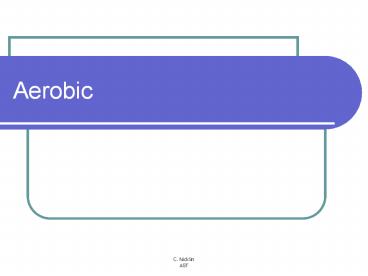C. Nicklin - PowerPoint PPT Presentation
1 / 80
Title: C. Nicklin
1
Aerobic
2
Agility
3
Aerobic
- with oxygen.
- If exercise is not too fast and is steady, the
heart can supply all the oxygen the muscles need.
4
Agility
- the ability to change the position of the body
quickly and to control the movement of the whole
body
5
Anaerobic
6
Balance
7
Anaerobic
- without oxygen.
- If exercise is done in short, fast bursts, the
heart cannot supply blood and oxygen to the
muscles as fast as the cells can use them.
8
Balance
- the ability to retain the centre of mass
(gravity) of the body above the base of support
with reference to static Balance (stationary
Balance) or dynamic Balance (changing Balance)
conditions of movement, shape and orientation.
9
Body composition
10
Cardiac output
11
Body composition
- the percentage of body weight which is fat,
muscle and bone.
- 3 extremes
- Endomorph (short/fat)
- Ectomorph (long/thin)
- Mesomorph (muscular)
12
Cardiac output
- the amount of blood ejected from the heart in one
minute - Heart rate x stoke volume
13
Cardiovascular
14
Cardiovascular Fitness
15
Cardiovascular
- The Heart,
- Blood
- and Blood vessels
16
Cardiovascular fitness
- the ability to exercise the entire body for long
periods of time
17
Co-ordination
18
D.R.A.B.C
19
Co-ordination
- the ability to use two or more body parts
together
20
D.R.A.B.C
- D Danger
- R Response
- A Airway
- B Breathing
- C Circulation
21
Exercise
22
Fitness
23
Exercise
- a form of physical activity done primarily to
improve ones health and physical fitness
24
Fitness
- the ability to meet the demands of the
environment
25
Health Related Fitness
26
Skill Related Fitness
27
Health Related Fitness
- Cardiovascular Fitness / Endurance
- Muscular Endurance
- Muscular Strength
- Flexibility
- Body Composition
- Speed
28
Skill Related Fitness
- Agility
- Balance
- Co-ordination
- Reaction Time
- Power
- Speed
29
Flexibility
30
Health
31
Flexibility
- the range of movement possible at a joint
32
Health
- a state of complete mental, physical and social
well-being, and not merely the absence of disease
and infirmity.
33
Heart rate
34
Isometric contractions
35
Heart rate
- the number of times the heart beats each minute
36
Isometric contractions
- muscle contraction which results in increased
tension but the length does not alter, - eg, when pressing against a stationary object
37
Isotonic contraction
38
Joint
39
Isotonic contraction
- muscle contraction that results in limb movement
40
Joint
- a place where two or more bones meet
41
Muscle tone
42
Muscular endurance
43
Muscle tone
- voluntary muscles in a state of very slight
tension, ready and waiting to beused
44
Muscular endurance
- the ability to use voluntary muscles, many times
without getting tired.
45
Muscular strength
46
Obese
47
Muscular strength
- the amount of force a muscle can exert against a
resistance.
48
Obese
- a term used to describe people who are very
overfat
49
Overload
50
Overfat
51
Overload
- fitness can only be improved through training
more than you normally do
52
Overfat
- a way of saying you have more body fat than you
should have
53
Overweight
54
Oxygen Debt
55
Overweight
- having weight in excess of normal.
- Not harmful unless accompanied byoverfat-ness
56
Oxygen Debt
- the amount of oxygen consumed during recovery
above that which wouldhave ordinarily been
consumed in the same time at rest (this results
in a shortfall in the oxygen available)
57
Performance
58
Power
59
Performance
- how well a task is completed
60
Power
- the ability to do strength performances quickly.
Power Strength x Speed.
61
Progression
62
Reaction time
63
Progression
- start slowly and gradually increase the amount of
exercise you do.
64
Reaction time
- the time between the presentation of a stimulus
and the onset of a movement.
65
Reversibility
66
R.I.C.E
67
Reversibility
- any adaptation that takes place as a consequence
of training will bereversed when you stop
training.
68
R.I.C.E
- Rest,
- Ice,
- Compression,
- Elevation
69
Specificity
70
Speed
71
Specificity
- you must do specific kinds of activity or
exercise to build specific bodyparts
72
Speed
- The differential rate at which an individual is
able to perform a movement orcover a distance in
a period of time - Time taken to move from A to B
73
Stroke volume
74
Tidal volume
75
Stroke volume
- the volume of blood pumped out of the heart by
each ventricle during onecontraction.
76
Tidal volume
- the amount of air breathed in or out of the lungs
in one breath.
77
Training
78
Vital capacity
79
Training
- a well-planned programme which uses scientific
principles to improveperformance, skill, game
ability and motor and physical fitness
80
Vital capacity
- the maximum amount of air that can be forcibly
exhaled after breathing inas much as possible.

